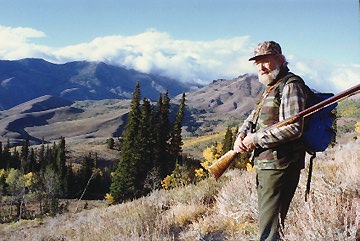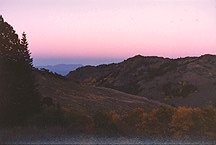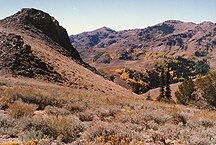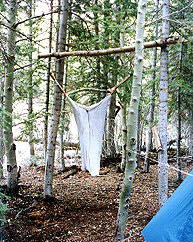

The sound of a big-bore muzzle loader slapped the air and went rumbling and bouncing around the valley like thunder. As if it were the two-minute warning gun before a sailboat race, my senses came to full alert and my attention snapped to the horizon line in front if me. If I was to get a shot at a deer this morning, I would have to see some sign of them along that ridge, and very soon. I unconsciously checked my gun for the umpteenth time and strained to see any motion along that horizon. Not really believing it would happen, but knowing exactly where the action, if any, would take place, I was startled to see the light reflecting off the points of a big set of antlers moving rapidly along the ridge line. A deer was running just below the ridge with only his rack showing above it. Amazingly, the plan had worked, and the time for me to play my part in it was rushing toward me.
When my friend Skip invited me and another friend, Dave, to hunt mule deer with him during the muzzle loading season in Nevada in September, 1989, we gladly accepted. Who could resist the chance to spend ten days in the high mountains in the west, hunting deer with a muzzle loader? It would be no small undertaking, since Dave and I lived in Louisville, Kentucky, and we would be flying to Elko, Nevada, carrying along all the personal gear necessary for camping and hunting.
During the ensuing months we made all the necessary plans, collected the gear, and tried to prepare ourselves for the shooting part of the hunt. Everything I had ever read about hunting in the mountains of the west emphasised the need for accurate, long range shooting, so I concentrated on that aspect. It worried me a good deal, because I think of the muzzle loading rifle shooting round balls as a short range gun. I would be shooting a percussion Hawken rifle which I had built from an Ozark Mountain Arms kit about five years before. It is .54 caliber, 34 inch barrel, one turn in 70 inches, and weighs nearly 10 pounds. I had zeroed the gun in for 100 yards, but I had never killed anything with the gun, in fact, had never pointed it at any game, large or small. Many long sessions were spent calculating the trajectories of my load and verifying the results on the range. Shooting 110 grains of FFFg Goex and a patched .530 caliber ball, I was able by the end of the summer to shoot useable groups at 150 yards, although I was determined not to try a shot at more than 125 yards. Could one get within that range of a western mule deer in the high mountains? I had no idea.
 When Dave and I arrived in Elko, Skip and another friend named Dave, immediately christened Dave Two, picked us up and we started our five hour drive to the northeast and the camp they had already established in our assigned hunting area. This was my first time on the ground in the mountains of the west, and the trip was an education. The area we were to hunt in is located in northeastern Nevada, in mountains at about 10,000 feet of elevation, near the edge of Jarbidge Federal Wilderness Area. This country is semi-arid, being mostly covered with sagebrush, rabbit bush and other such dry-land vegetation. Aspens thrive, but mostly in patches of a few acres located in the drainages, and intermingled with spruce, fir and other conifers. A short, gnarled tree locally known as mountain mahogany is very abundant, growing singly or in patches at the higher elevations. Very different from the lush greenery of Kentucky, but beautiful in the extreme.
When Dave and I arrived in Elko, Skip and another friend named Dave, immediately christened Dave Two, picked us up and we started our five hour drive to the northeast and the camp they had already established in our assigned hunting area. This was my first time on the ground in the mountains of the west, and the trip was an education. The area we were to hunt in is located in northeastern Nevada, in mountains at about 10,000 feet of elevation, near the edge of Jarbidge Federal Wilderness Area. This country is semi-arid, being mostly covered with sagebrush, rabbit bush and other such dry-land vegetation. Aspens thrive, but mostly in patches of a few acres located in the drainages, and intermingled with spruce, fir and other conifers. A short, gnarled tree locally known as mountain mahogany is very abundant, growing singly or in patches at the higher elevations. Very different from the lush greenery of Kentucky, but beautiful in the extreme.
We arrived in camp at about 5:30 PM, and Dave and I started to unpack. Skip put a stop to that by saying, "Let's go hunt!" We left our guns in the tent and joined Skip for his evening hunt, since we were both still completely unprepared. He drove us a couple of miles along a ridge and left us by the truck while he probed into a small thicket of aspen near the road. Dave One was glassing the slope above us when he saw a small mulie bound from the aspen thicket and stop on the ridge. He was just telling me to look at the deer when a shot rang out, and he began to jump up and down and exclaimed, "He hit it! He hit it! I saw the ball hit the chest!" Sure enough, the deer ran a short distance and went down. In camp less than an hour, and one deer collected, already. Hey, this might be an alright hunt!
A half-hour before dawn the next morning, I found myself sitting in the sage very near that same spot,  positioned there by Skip and shown where he expected any deer moving in the area to show up. Sitting there that first morning, overlooking the panorama of mountains while the sun slowly rose, watching the gorgeous play of light on the peaks and valleys, aspen, spruce and sage was a very moving experience for me. I was mesmerized by the beauty around me, overwhelmed by the tremendous scale of the landscape. I was sitting in the absolute open sage, with no cover, but I had no difficulty holding still, because my attention was directed not at the thicket and the deer, but outward to the magnificent display nature provided for us. I dearly love the mountains. I felt as if I had come home, that I truly belonged there. Regardless of the outcome of the hunt, I was very glad I had come on this trip.
positioned there by Skip and shown where he expected any deer moving in the area to show up. Sitting there that first morning, overlooking the panorama of mountains while the sun slowly rose, watching the gorgeous play of light on the peaks and valleys, aspen, spruce and sage was a very moving experience for me. I was mesmerized by the beauty around me, overwhelmed by the tremendous scale of the landscape. I was sitting in the absolute open sage, with no cover, but I had no difficulty holding still, because my attention was directed not at the thicket and the deer, but outward to the magnificent display nature provided for us. I dearly love the mountains. I felt as if I had come home, that I truly belonged there. Regardless of the outcome of the hunt, I was very glad I had come on this trip.
Anxious to put me and the Daves on deer, Skip scouted to the end of the ridge, set up his spotting scope, and located seven nice bucks bedded for the day below a tremendous stone outcrop, in a stand of mahogany on a very steep slope. He described all this to us upon his return to camp, and devised a plan for getting at them. Dave Two had yet to shoot a deer on this trip, and had to leave that evening, so he was selected to try to approach the deer from above, down a very steep area of loose rocks. To keep the attention of the deer diverted from him, Skip would go a quarter-mile out the ridge beyond the herd and set up his spotting scope in plain sight, far enough away to be no imminent threat, close enough to rivet their attention. Dave Two would stalk them, watching Skip for advice, and Dave One and I would hike a half-mile in to a position below them, on the most probable route of escape.
We were let off well out of sight of the herd, and began our hike. The directions sounded very simple in the truck, but the area looked very different on the ground. We had a stiff breeze blowing in our faces, so felt good about scent and reasonable noise, but the terrain was rugged and steep, hard to negotiate. First cover was mahogany, very thick, then a small clearing, very steep and eroded, then a heavy stand of spruce. This last was criss-crossed by heavy deer trails, and sign was everywhere, more than I've ever seen. We moved about one hundred yards beyond the spruce, into a sage clearing with only three or four isolated conifers, talked over the probable best stands, and took cover. I was sitting in the open sage up the slope, 125 yards below the scree, and Dave about 75 yards below me, behind a large outcrop of stone. We felt we had all trails covered, but our confidence was not particularly high.
We hadn't been there more than fifteen minutes when the quiet was shattered by that heavy bellow of a large caliber muzzle loader. Dave Two had obviously been successful in his stalk, and we figured he had a buck down. Our adrenalin levels rose, because if we were to get a shot, it would be soon. Less than a minute later I saw that beautiful sight, sunlight glinting off a nice set of tall antlers! Deer were running straight at us at about 250 yards distance, only their antlers visible above the ridge. Soon four bucks topped the ridge, running hell-bent-for-leather, straight at Dave One. They dropped out of sight to me as they traversed the rolling terrain, but immediately reappeared, down hill, running fast. I remember talking to myself, to the deer, to Dave as they steamrolled toward him. I cocked my Hawken, but didn't set the trigger. I saw Dave raise his gun, rise from his stand, lean far out over the rock in front of him as the deer approached him headlong, the beautiful biggest buck leading. By now I am shouting in my mind , "Shoot, Dave, Shoot, Shoot, Shoot!!" Finally he did, but I heard only his percussion cap fire-- he had a misfire! I raised my rifle and tracked the lead buck as they all veered sharply to their right, straight up the hill, ran fifty yards, then veered again to their left to parallel their original track. They were obviously going to pass very close to me. I set the trigger, thought "I can't hit a running deer!", and at about 35 yards, as they approached the gap between me and Dave One, raised to my knees and fired. Smoke blossomed, blotting out all sight of the buck, but the brisk breeze whisked it away at once, and I saw the big buck down right where he was when I fired, thrashing. I do not remember the sight picture, but I know I shot him as I would have a rabbit with a shotgun, both eyes open. I had hit him high in the back, severing his spine, pitching him on his nose. My pulse was probably about 120, I remember saying repeatedly to myself, "My God, I've killed a deer"!, and I poured the first two quick-loads of powder on the back of my hand before I managed to reload and cap. Frantic, Dave One recapped and popped two more at the other deer as they fled back down the steep slope past him, but his gun just would not fire. The downed buck was slowly thrashing his way down the slope, which I realized we would have to carry him up again, so I rushed to him and placed a shot through the chest, angled far forward, which killed him quickly. He was what westerners call a 3 x 2, and probably field dressed at about 150-175 pounds.
straight at us at about 250 yards distance, only their antlers visible above the ridge. Soon four bucks topped the ridge, running hell-bent-for-leather, straight at Dave One. They dropped out of sight to me as they traversed the rolling terrain, but immediately reappeared, down hill, running fast. I remember talking to myself, to the deer, to Dave as they steamrolled toward him. I cocked my Hawken, but didn't set the trigger. I saw Dave raise his gun, rise from his stand, lean far out over the rock in front of him as the deer approached him headlong, the beautiful biggest buck leading. By now I am shouting in my mind , "Shoot, Dave, Shoot, Shoot, Shoot!!" Finally he did, but I heard only his percussion cap fire-- he had a misfire! I raised my rifle and tracked the lead buck as they all veered sharply to their right, straight up the hill, ran fifty yards, then veered again to their left to parallel their original track. They were obviously going to pass very close to me. I set the trigger, thought "I can't hit a running deer!", and at about 35 yards, as they approached the gap between me and Dave One, raised to my knees and fired. Smoke blossomed, blotting out all sight of the buck, but the brisk breeze whisked it away at once, and I saw the big buck down right where he was when I fired, thrashing. I do not remember the sight picture, but I know I shot him as I would have a rabbit with a shotgun, both eyes open. I had hit him high in the back, severing his spine, pitching him on his nose. My pulse was probably about 120, I remember saying repeatedly to myself, "My God, I've killed a deer"!, and I poured the first two quick-loads of powder on the back of my hand before I managed to reload and cap. Frantic, Dave One recapped and popped two more at the other deer as they fled back down the steep slope past him, but his gun just would not fire. The downed buck was slowly thrashing his way down the slope, which I realized we would have to carry him up again, so I rushed to him and placed a shot through the chest, angled far forward, which killed him quickly. He was what westerners call a 3 x 2, and probably field dressed at about 150-175 pounds.
 Jubilation reigned! Dave One rushed to shake my hand, we laughed and chattered crazily, and my mouth was so dry it was actually glued together. Dave One was beside himself with excitement, repeatedly exclaiming how close that buck had been to him when he attempted to fire. We were dazed, and as I set about field dressing the deer we must have looked like two kids on Christmas morning. I couldn't find my rope or knife, the plastic bags, squirt bottle or my own head, but I made a start at the field dressing. As I finished the job, Skip and Dave Two popped over the rise, and Skip yelled "I see blood, somebody killed a deer, who did it?" I raised my hand, giggled, and the wild chattering started all over again.
Jubilation reigned! Dave One rushed to shake my hand, we laughed and chattered crazily, and my mouth was so dry it was actually glued together. Dave One was beside himself with excitement, repeatedly exclaiming how close that buck had been to him when he attempted to fire. We were dazed, and as I set about field dressing the deer we must have looked like two kids on Christmas morning. I couldn't find my rope or knife, the plastic bags, squirt bottle or my own head, but I made a start at the field dressing. As I finished the job, Skip and Dave Two popped over the rise, and Skip yelled "I see blood, somebody killed a deer, who did it?" I raised my hand, giggled, and the wild chattering started all over again.
Dragging a heavy buck up a steep slope for a quarter mile at 10,000 feet altitude is hard, hot, thirsty work. The two Daves accomplished it by brute force, while I, thanks to the fact they were taught respect for their elders, carried up the packs and guns for all of us. High altitude is hard on flatlanders, believe you me. Skip went to bring the truck to the aspen thicket at the switch-back, and in about half an hour my deer was on its way to camp.
Skip is very meticulous in his deer cleaning method, and never takes a shortcut. The deer was skinned immediately, washed down and bagged in a heavy cloth pinned shut against insects. Each day it was wrapped in an old sleeping bag to keep heat out, and each night opened to cool. It's a good method, and I've never eaten better venison.
What an adventure. This was the very first black powder deer I had ever killed, and I couldn't have hoped for a better situation to do it in. Marvelous scenery, great companions and muzzle loading hunting are a winning combination. To have taken my first deer with a muzzle loader, and with him in full flight, up close and personal, just added spice to the mix. It set a pattern, too, because, although I've killed a lot of deer since then, they have all been taken with a smokepole. It's the only way to hunt. It also answered that question which had been in my mind from the beginning, and I now know you can get a close shot at a western mulie.

Copyright ©1999 B. E. Spencer
All rights reserved.